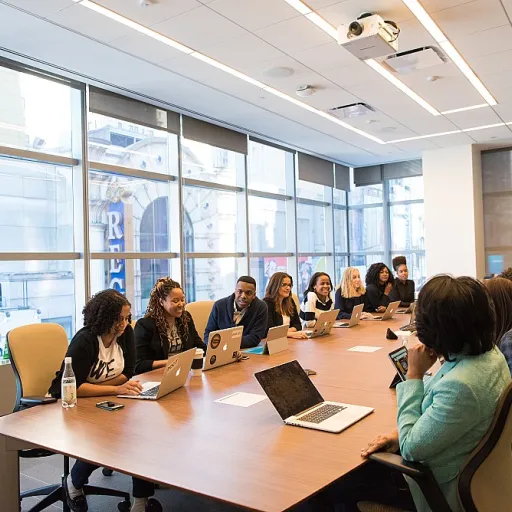
Understanding Harassment-Free Culture
Fostering a Culture of Respect
Understanding the foundational elements of a harassment-free workplace is pivotal for any organization aiming to nurture a healthy work environment. At its core, a harassment-free culture is one where respect and dignity take precedence, and all employees feel safe and valued. It requires a comprehensive approach involving workplace policies, training initiatives, and vigilance against unacceptable behavior.
Anti-harassment policies serve as the backbone of this environment, delineating what constitutes workplace harassment and highlighting consequences for offenders. Clear policies not only deter potential misconduct but also empower employees to speak up without fear of retaliation, fostering an atmosphere where prevention is prioritized.
In addition to robust policies, regular prevention training equips employees with the necessary tools to identify and report instances of harassment. Such training emphasizes the importance of understanding nuances, including behaviors of a sexual nature and creating a respectful workplace culture. Employers should consistently evaluate these strategies to ensure they are effective and adapt them to meet evolving challenges within the corporate culture.
By promoting an inclusive environment, organizations demonstrate their commitment to a harassment-free workplace. Leadership plays a critical role in this cultural shift by modeling respectful behavior and setting a high standard for acceptable conduct. This proactive stance helps to embed a pervasive understanding of harassment prevention within the organization.
For those seeking to enhance their understanding of fostering a respectful and balanced work culture, exploring resources on emotional intelligence can offer valuable insights. For more information on harnessing emotional will for better work-life balance, you can click here.
Self-Reflection: Assessing Your Behavior
Self-Evaluation: Inspecting Our Personal Contributions
In striving to foster a harassment-free environment, self-reflection plays a pivotal role. As employees, understanding our own behavior within the workplace is crucial in promoting a positive culture. Evaluate your interactions with colleagues, and consider how your words and actions may impact others. Be mindful of the subtle nuances this entails, such as joking of a sexual nature, which may inadvertently contribute to workplace harassment.
Recognizing the need for improvement is the first step towards meaningful change. Honest self-assessment helps uncover potential alterations in our behavior necessary to maintain a respectful and harassment-free workplace. Becoming aware of our biases and how they can shape interactions will help in crafting a supportive workplace culture.
- Reflect on instances where your behavior may have been misinterpreted.
- Assess how aligned your actions are with the anti-harassment policies of your organization.
- Identify areas where harassment prevention training could assist you in becoming more aware and responsible within the workplace.
For those keen on further exploration, navigating workers' compensation may provide insight into how personal behavior influences workplace dynamics.
Communication: The Key to a Respectful Workplace
Effective Communication Strategies to Foster Respect
Creating a harassment-free work environment is fundamentally tied to effective communication within the organization. While your workplace culture plays a significant role, it is your behavior and interactions that set the tone for respectful exchanges among employees. Open dialogues not only help in maintaining a harmonious workplace but also in preventing workplace harassment. Here’s how effective communication can be leveraged:- Encourage Open Conversations: Cultivate a workplace where employees feel comfortable discussing harassment concerns. By promoting transparency, you empower individuals to share their experiences and seek help when necessary.
- Regular Training: Implement regular harassment prevention training sessions. These sessions should cover the understanding of harassment and empower employees to communicate effectively about their personal experiences.
- Clear Policies and Procedures: Ensure that anti-harassment policies are clearly stated and accessible. Employers should provide detailed explanations on how to report issues and the steps involved in resolving complaints.
- Active Listening: Encourage leaders and employees alike to actively listen to their peers. This behavior fosters a supportive environment, allowing the organization to swiftly address issues that arise.
- Feedback Mechanisms: Establish channels for employees to offer feedback about workplace experiences. Regular surveys and feedback forms can help assess the temperature of the workplace culture and identify areas for improvement.
Setting Boundaries: Balancing Professionalism and Personal Space
Creating Personal and Professional Space
Balancing professionalism and maintaining personal space is a delicate yet crucial component in cultivating a harassment-free work environment. Understanding the need for boundaries and how they contribute to a respectful workplace is essential for fostering a culture that prioritizes mutual respect and dignity. Establishing clear boundaries is a proactive measure that can help prevent situations that may lead to discomfort or misunderstandings among employees. Encouraging this practice within your organization not only strengthens the corporate culture but also aligns with existing harassment policies, creating an environment conducive to employee well-being. Implementing prevention training sessions can equip employees with the tools to assert their boundaries respectfully and recognize when they are being encroached upon. This knowledge empowers employees to voice concerns about workplace harassment, reinforcing a free workplace culture where everyone feels safe and valued. Moreover, it's important that your behavior and that of your peers reflect the values of a harassment-free environment. Demonstrating professionalism while respecting personal space sets a positive precedent for others to follow. This act is not only beneficial for individual employees but serves as a deterrent against potential sexual harassment of any nature. Leadership plays a pivotal role in modeling these behaviors and shaping the organization’s culture. When leaders prioritize balance between professional expectations and personal boundaries, it signals to employees that their employer values both their professional contributions and personal comfort. In conclusion, setting and respecting boundaries in the workplace is a fundamental aspect of fostering a respectful and harassment-free environment. It helps in solidifying the organization's stance against workplace harassment, supporting a thriving and respectful workplace culture.Leadership's Role in Cultivating a Positive Culture
Leadership: Paving the Way for a Respectful Environment
Cultivating a harassment-free workplace starts with leadership. Employers play a pivotal role in fostering an environment where employees feel respected and valued. Strong leadership not only helps in preventing workplace harassment but also sets the tone for the overall workplace culture.- Demonstrate Commitment: Employers should visibly demonstrate their commitment to a harassment-free environment. Communicating anti-harassment policies effectively ensures everyone understands the importance of maintaining a respectful space.
- Implement Policies: The foundation of a harassment-free culture lies in clear harassment policies. Organizations must develop robust harassment prevention strategies, providing a framework employees can rely on. This includes comprehensive sexual harassment prevention training, which should be mandatory for all employees.
- Lead by Example: Leadership needs to model the behavior they expect from their employees. By displaying respectful and inclusive behavior, leaders encourage employees to mirror these actions, leading to a cohesive and healthy workplace environment.
- Proactive Prevention: It’s crucial to shift from reactive measures to proactive prevention when tackling issues of harassment. Regular reviews of policies, coupled with continuous discussions about workplace harassment, ensure that the organization adapts to changes, thereby promoting a harassment-free culture continuously.
Continuous Improvement: Adapting to Change
Embracing Progress in a Dynamic Landscape
In today's ever-evolving work environment, fostering a harassment-free culture requires ongoing commitment and adaptability. An organization that continuously evaluates and updates its harassment policies sets a strong foundation for a respectful workplace. Here’s how you can ensure continuous improvement in cultivating a positive culture:- Regular Training and Education: To effectively combat workplace harassment, periodic harassment prevention training is essential. Training sessions should be interactive, up-to-date, and relevant to the evolving workplace culture. By providing employees with the necessary tools and understanding, they are better equipped to recognize and address inappropriate behavior.
- Feedback Mechanisms: Implementing a system where employees feel safe to share their experiences and suggestions can help your organization adapt its policies and practices. These mechanisms allow for honest dialogue about the work environment and are critical for identifying blind spots in your anti harassment strategy.
- Leadership Commitment: Effective leadership is crucial in adapting and shaping a culture that prioritizes dignity and respect for each employee. Leaders should regularly review and reinforce the organization's commitment to preventing workplace harassment, ensuring they lead by example and continuously push for positive growth in your organization's environment.
- Evaluating Success and Making Adjustments: Harassment prevention efforts should not be static. Organizations must routinely assess the effectiveness of their harassment prevention measures. Make use of data and employee feedback to drive improvements, ensuring your culture remains both inclusive and progressive.
- Adopting New Technologies: Explore technological solutions that aid in creating a paper free, streamlined approach to your organization's training and reporting processes. These solutions can provide accessible platforms for prevention training and help maintain an informed workforce.












